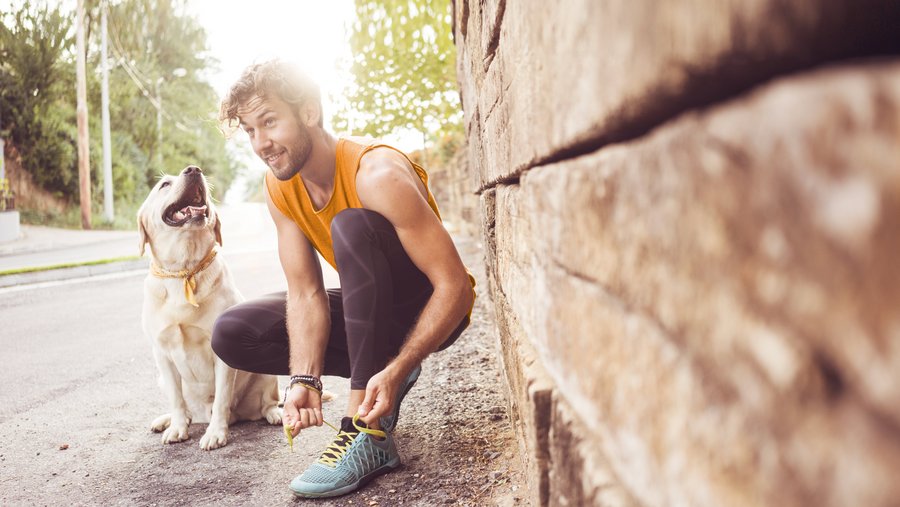Before you get started with your dog, you should check a few things. Is your running partner old enough (i.e. fully grown)? Only then are the bones and tendons stable enough for the strain of running. Depending on the breed, growth is completed between seven and 24 months of age. No dog should jog before it is one year old.
Your dog should also not be too old. If you are unsure, ask your vet to confirm that your dog’s joints and circulation allow for running. And not every breed is made for jogging. Hunting and working dogs are generally well suited but large, heavy, short-snouted, or short-legged breeds are less so. And finally: does your dog even enjoy jogging? You can only find this out by trial and error.
At the beginning, you say: “Heel”.
Before you start walking your dog, you should make sure that it walks safely on a loose lead. Anything else will lead to stress or unpleasant incidents. You can also make some preparations when it comes to equipment. A special jogging lead allows you to keep your hands free. Attention: the jogging lead may not be attached to a collar. In addition, the flexible centre section ensures that small inconsistencies in speed are not immediately punished with a jolt. You may also want to treat your training partner to a “jogging harness”. This can be a valuable indicator for you: If your dog crumbles as soon as you bring it out, jogging is probably not its thing. However, if it looks at you happily, you can be sure that your four-legged friend likes jogging. And immediately goes into “training mode” when the harness is put on.
Step by step to the goal.
As with all training, you start gradually when jogging together. You can practise this before you throw on your sports gear and get started. For example, during regular walks. To do this, first walk short passages at a brisk walk and then transition to a slow trot. Then you slowly move on again. This teaches your dog to adapt to changing walking speeds right from the start. To start with, you can introduce a special command when you change your speed. This will prevent your four-legged friend from falling into the lead every time you switch to walking. If you practise these changes of pace long enough, your dog will become increasingly more attentive and adapt to your speed even without a command.
And off we go with the first running session.
You create ideal conditions for the first real training session: This includes a quiet time of day, a calm environment, and a soft surface to protect joints and paws. You should also jog at a comfortable temperature (i.e. between 10 and 15°C). The last feeding was at least two hours ago. Of course, your dog is allowed to warm up before the real action begins. It first takes a walk, sniffs around, and does its business. So that your four-legged friend is not distracted by its needs during training. In future, this will be your check-list before every run. Then you can get started together. For the time being, short stages of a few minutes are sufficient. Then slowly stretch them out. You know your dog best and what you can put it through.
Fun instead of tension
Fun is the most important part of your running training. You must adapt to your dog – and not the other way round. In concrete terms: Your four-legged friend should determine the speed, duration, and frequency of your training sessions. Keep a close eye on your pet, and finish training too early rather than too late. Some dogs keep running to please “their humans” – even if they don’t really want to any more. Praise your pet extensively and make sure you take regular breaks. Remember to take water for both of you on longer runs. Also keep in mind: even animals get sore muscles. You can recognise this by the fact that your four-legged friend has difficulty standing up or walks a little stiffly. This means it’s time for calmer movements and relaxed walks. Four-legged training partners often like to be gently massaged at such times. Why don’t you try it out and see if your dog is one of them? As soon as your dog is relaxed again, you can start the next round.

